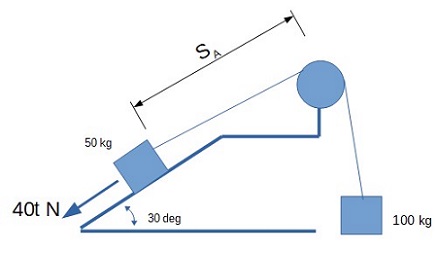
Elements Of Electromagnetics
7th Edition
ISBN: 9780190698614
Author: Sadiku, Matthew N. O.
Publisher: Oxford University Press
expand_more
expand_more
format_list_bulleted
Concept explainers
Question
A frictionless pulley is used to hoist or lower mass A (100 Kg) vertically upwards as the mass B (50 Kg) is pulled down the rough incline plane (? = 0.25, angle of inclination = 30 degrees) with a force P = 40t N parallel to the incline plane, where t is time in seconds.
(a) Draw free body diagrams of mass A and B.
(b) Establish the relationship between the velocity and acceleration of the particles.
(c) Write down the equation of motion for the particles and determine the acceleration of particles A as a function of time.
(d) Given that at t = 0, sA 10m, VA=O, determine when motion of mass A stops and the tension in the cable at that instant.

Transcribed Image Text:SA
50 kg
40t NA
30 deg
100 kg
Expert Solution
This question has been solved!
Explore an expertly crafted, step-by-step solution for a thorough understanding of key concepts.
Step by stepSolved in 5 steps with 8 images

Knowledge Booster
Learn more about
Need a deep-dive on the concept behind this application? Look no further. Learn more about this topic, mechanical-engineering and related others by exploring similar questions and additional content below.Similar questions
- 1 Problem During a particularly snowy winter in Charlotte, a child of mass m slides down a ramp starting at rest from point A and encounters the melted grassy area at B before coming to a full stop at C. Assume the ice is frictionless. The height of point A is hĄ and the distance between B and C is L. What is the coefficient of friction of the grass, k? Assume that g = 9.81 m/s², ha = 5 m, m = 20 kg, and L = 10 m. hA P JA Ice B Grass L Carrow_forwardWeight=481N please explain steps thank youarrow_forwardTwo objects m1 = 5.15 kg and m2 = 2.95 kg)are connected by a light string passing over a light, frictionless pulley as in the figure below. The 5.15-kg object is released from rest at a point h = 4.00 m above the table. (a) Determine the speed of each object when the two pass each other. m/s(b) Determine the speed of each object at the moment the 5.15-kg object hits the table. m/s(c) How much higher does the 2.95-kg object travel after the 5.15-kg object hits the table? marrow_forward
arrow_back_ios
arrow_forward_ios
Recommended textbooks for you
 Elements Of ElectromagneticsMechanical EngineeringISBN:9780190698614Author:Sadiku, Matthew N. O.Publisher:Oxford University Press
Elements Of ElectromagneticsMechanical EngineeringISBN:9780190698614Author:Sadiku, Matthew N. O.Publisher:Oxford University Press Mechanics of Materials (10th Edition)Mechanical EngineeringISBN:9780134319650Author:Russell C. HibbelerPublisher:PEARSON
Mechanics of Materials (10th Edition)Mechanical EngineeringISBN:9780134319650Author:Russell C. HibbelerPublisher:PEARSON Thermodynamics: An Engineering ApproachMechanical EngineeringISBN:9781259822674Author:Yunus A. Cengel Dr., Michael A. BolesPublisher:McGraw-Hill Education
Thermodynamics: An Engineering ApproachMechanical EngineeringISBN:9781259822674Author:Yunus A. Cengel Dr., Michael A. BolesPublisher:McGraw-Hill Education Control Systems EngineeringMechanical EngineeringISBN:9781118170519Author:Norman S. NisePublisher:WILEY
Control Systems EngineeringMechanical EngineeringISBN:9781118170519Author:Norman S. NisePublisher:WILEY Mechanics of Materials (MindTap Course List)Mechanical EngineeringISBN:9781337093347Author:Barry J. Goodno, James M. GerePublisher:Cengage Learning
Mechanics of Materials (MindTap Course List)Mechanical EngineeringISBN:9781337093347Author:Barry J. Goodno, James M. GerePublisher:Cengage Learning Engineering Mechanics: StaticsMechanical EngineeringISBN:9781118807330Author:James L. Meriam, L. G. Kraige, J. N. BoltonPublisher:WILEY
Engineering Mechanics: StaticsMechanical EngineeringISBN:9781118807330Author:James L. Meriam, L. G. Kraige, J. N. BoltonPublisher:WILEY

Elements Of Electromagnetics
Mechanical Engineering
ISBN:9780190698614
Author:Sadiku, Matthew N. O.
Publisher:Oxford University Press

Mechanics of Materials (10th Edition)
Mechanical Engineering
ISBN:9780134319650
Author:Russell C. Hibbeler
Publisher:PEARSON

Thermodynamics: An Engineering Approach
Mechanical Engineering
ISBN:9781259822674
Author:Yunus A. Cengel Dr., Michael A. Boles
Publisher:McGraw-Hill Education

Control Systems Engineering
Mechanical Engineering
ISBN:9781118170519
Author:Norman S. Nise
Publisher:WILEY

Mechanics of Materials (MindTap Course List)
Mechanical Engineering
ISBN:9781337093347
Author:Barry J. Goodno, James M. Gere
Publisher:Cengage Learning

Engineering Mechanics: Statics
Mechanical Engineering
ISBN:9781118807330
Author:James L. Meriam, L. G. Kraige, J. N. Bolton
Publisher:WILEY